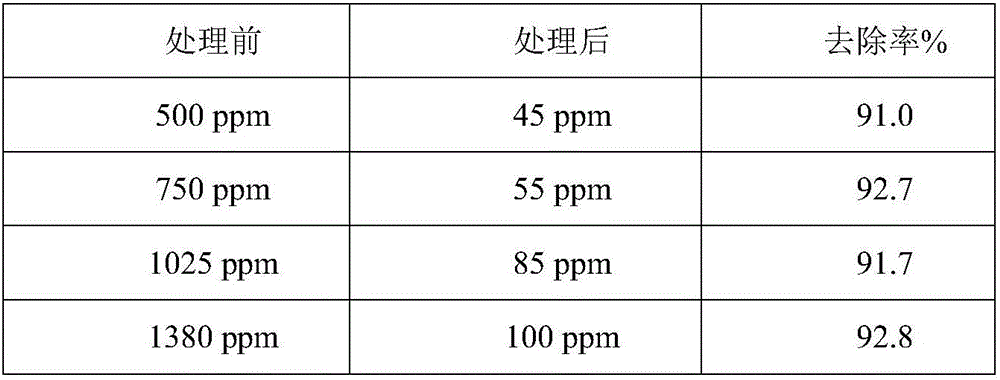Photochemical preparation method of single atom Au for catalytic degradation of VOCs
A catalytic degradation and photochemical technology, applied in the field of preparation of single-atom Au, can solve the problems of no single-atom catalyst catalytic degradation VOCs patent, how VOCs degradation ability remains to be investigated, low load processing efficiency, etc., to achieve novel preparation method and process The effect of novelty, novelty and high efficiency
- Summary
- Abstract
- Description
- Claims
- Application Information
AI Technical Summary
Problems solved by technology
Method used
Image
Examples
preparation example Construction
[0026] The photochemical preparation method of single-atom Au for catalytic degradation of VOCs of the present invention comprises the following steps:
[0027] Step 1. Preparation of atomically thick TiO 2 Nanosheets:
[0028] (a) TiCl 3 Add ethylene glycol into the reactor, stir mechanically, and react completely at 100-200°C, the TiCl 3 The mass ratio with ethylene glycol is 1:10~40, and the mass percentage concentration of described ethylene glycol is 60%;
[0029] (b) centrifugally filtering the reacted liquid, and then drying the separated precipitate in an oven at 70-110° C. to remove moisture to obtain a dry solid;
[0030] (c) Grinding the dry solid, then passing through a sieve to obtain 40-60 mesh TiO 2 Nano powder;
[0031] Step 2. Using photochemical method to support single atom Au:
[0032] (a) TiO 2 The nano powder is dispersed in deionized water and ultrasonically dispersed to obtain TiO 2 uniform dispersion;
[0033] (b) Add HAuCl to the dispersion w...
Embodiment 1
[0047] Step 1. Preparation of atomically thick TiO 2 Nanosheets:
[0048] (a) TiCl 3 Add ethylene glycol into the reactor, stir at 200r / min, react at 100°C for 6h, the TiCl 3 The mass ratio with ethylene glycol is 1:10, and the mass percent concentration of said ethylene glycol is 60%;
[0049] (b) centrifugally filtering the reacted liquid, and then drying the separated precipitate in an oven at 70° C. for 6 hours to remove moisture to obtain a dry solid;
[0050] (c) Grinding the dry solid, then passing through a sieve to obtain 40-60 mesh TiO 2 Nano powder;
[0051] Step 2. Using photochemical method to support single atom Au:
[0052] (a) TiO 2 The nano powder was dispersed in deionized water and ultrasonically dispersed for 0.5h to obtain TiO 2 uniform dispersion;
[0053] (b) Add HAuCl to the dispersion while stirring the dispersion continuously 4 Solution, stirring speed is 100r / min, stirs 30min to obtain mixed solution; Described HAuCl 4 The concentration of ...
Embodiment 2
[0073] Step 1. Preparation of atomically thick TiO 2 Nanosheets:
[0074] (a) TiCl 3 Add ethylene glycol into the reactor, stir at 300r / min, react at 150°C for 5h, the TiCl 3 The mass ratio with ethylene glycol is 1:20, and the mass percent concentration of said ethylene glycol is 60%;
[0075] (b) Centrifugally filter the reacted liquid, and then dry the separated precipitate in an oven at 90° C. for 5 hours to remove moisture to obtain a dry solid;
[0076] (c) Grinding the dry solid, then passing through a sieve to obtain 40-60 mesh TiO 2 Nano powder;
[0077] Step 2. Using photochemical method to support single atom Au:
[0078] (a) TiO 2 The nano powder was dispersed in deionized water and ultrasonically dispersed for 0.5h to obtain TiO 2 uniform dispersion;
[0079] (b) Add HAuCl to the dispersion while stirring the dispersion continuously 4 Solution, stirring speed is 100r / min, stirs 25min to obtain mixed solution; Described HAuCl 4 The concentration of the so...
PUM
| Property | Measurement | Unit |
|---|---|---|
| Dominant wavelength | aaaaa | aaaaa |
| Concentration | aaaaa | aaaaa |
Abstract
Description
Claims
Application Information
 Login to View More
Login to View More - R&D
- Intellectual Property
- Life Sciences
- Materials
- Tech Scout
- Unparalleled Data Quality
- Higher Quality Content
- 60% Fewer Hallucinations
Browse by: Latest US Patents, China's latest patents, Technical Efficacy Thesaurus, Application Domain, Technology Topic, Popular Technical Reports.
© 2025 PatSnap. All rights reserved.Legal|Privacy policy|Modern Slavery Act Transparency Statement|Sitemap|About US| Contact US: help@patsnap.com



